Search by Category
- Marg Digital Health
- Marg Nano
- Swiggy & Zomato
- ABHA - Ayushman Bharat
- Marg Cloud
-
Masters
- Ledger Master
- Account Groups
- Inventory Master
- Rate and Discount Master
- Refresh Balances
- Cost Centre Master
- Opening Balances
- Master Statistics
- General Reminder
- Shortage Report
- Supplier Vs Company
- Temporary Limit
- Shop QRID and eBusiness
- Cloud Backup Setup
- Password and Powers
- Marg Licensing
- Marg Setup
- Target
- Budget
- Credit Limit Management
- Change ERP Edition
- Ease Of Gst Adoption
-
Transactions
- ERP To ERP Order
- Sale
- Purchase
- Sale Return
- Purchase Return
- Brk / Exp Receive
- Scrap Receive
- Brk / Exp Issue
- Scrap Issue
- GST Inward
- GST Outward
- Replacement Issue
- Replacement Receive
- Stock Issue
- Stock Receive
- Price Diff. Sale
- Price Diff. Purchase
- BOM
- Conversion
- Quotation
- Sale Order
- Purchase Order
- Dispatch Management
- ERP Bridger
- Transaction Import
- Download From Server
- Approvals
- Pendings
- Accounts
- Online Banking
-
Books
- Cash and Bank Book
- All Ledgers
- Entry Books
- Debtors Ledgers
- Creditors Ledger
- Purchase Register
- Sale Register
- Duties & Taxes
- Analytical Summaries
- Outstandings
- Collection Reports
- Depreciation
- T-Format Printing
- Multi Printing
- Bank Reconcilation
- Cheque Management
- Claims & Incentives
- Target Analysis
- Cost Centres
- Interest and Collection
- Final Reports
-
Stocks
- Current Stock
- Stock Analysis
- Filtered Stock
- Batch Stock
- Dump Stock
- Hold/Ban Stock
- Stock Valuation
- Minimum Level Stock
- Maximum Level Stock
- Expiry Stock
- Near Expiry Stock
- Stock Life Statement
- Batch Purchase Type
- Departments Reports
- Merge Report
- Stock Ageing Analysis
- Fast and Slow Moving Items
- Crate Reports
- Size Stock
-
Daily Reports
- Daily Working
- Fast SMS/E-Mail Reports
- Stock and Sale Analysis
- Order Calling
- Business on Google Map
- Sale Report
- Purchase Report
- Inventory Reports
- ABC Analysis
- All Accounting Reports
- Purchase Planning
- Dispatch Management Reports
- SQL Query Executor
- Transaction Analysis
- Claim Statement
- Upbhogkta Report
- Mandi Report
- Audit Trail
- Re-Order Management
- Reports
-
Reports Utilities
- Delete Special Deals
- Multi Deletion
- Multi Editing
- Merge Inventory Master
- Merge Accounts Master
- Edit Stock Balance
- Edit Outstanding
- Re-Posting
- Copy
- Batch Updation
- Structure/Junk Verificarion
- Data Import/Export
- Create History
- Voucher Numbering
- Group of Accounts
- Carry Balances
- Misc. Utilities
- Advance Utilities
- Shortcut Keys
- Exit
- Generals
- Backup
- Self Format
- GST Return
- Jewellery
- eBusiness
- Control Room
- Advance Features
- Registration
- Add On Features
- Queries
- Printing
- Networking
- Operators
- Garment
- Hot Keys
-
GST
- E-Invoicing
- Internal Audit
- Search GSTIN/PARTY
- Export Invoice Print
- Tax Clubbing
- Misc. GST Reports
- GST Self-Designed Reports
- GST Return Video
- GSTR Settings
- Auditors Details
- Update GST Patch
- Misc. GST Returns
- GST Register & Return
- GST RCM Statement
- GST Advance Statement
- GST Payment Statement
- Tax Registers and Summaries
- TDS/TCS Reports
- Form Iss./Receivable
- Mandi
- My QR Code
- E-Way Bill
- Marg pay
- Saloon Setup
- Restaurant
- Pharmanxt free Drugs
- Manufacturing
- Password and Power
- Digital Entry
Home > Margerp > Audit Trail > How to enable Audit Trail in Marg Software ?
How to enable Audit Trail in Marg Software ?
Overview of Audit Trail in Marg Software
Process to Enable Audit Trail Option in Marg Software
Process of Audit Trail in Marg Software
OVERVIEW OF AUDIT TRAIL IN MARG SOFTWARE
- In Marg ERP Software ‘Audit Trail’ option used to record each and every financial transaction done in the accounting software.
- Also, they must be able to create logs of each change made in the books of accounts, along with the date and user details and to ensure that the audit trail cannot be disabled.
- Basically the Audit Trail option consist of three options i.e. Bill Value Changes, User Audit Trail, Random Stock Checking. So in this article we will discuss it one by one.
PROCESS TO ENABLE AUDIT TRAIL OPTION IN MARG SOFTWARE
- Firstly, Go to Masters >> Marg Setups >> Control Room.
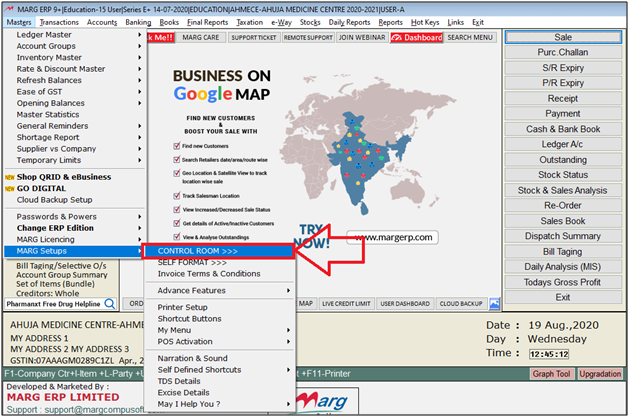
- A 'Control Room' window will appear.
- The user will select ‘Search in all’. Press 'Enter'.
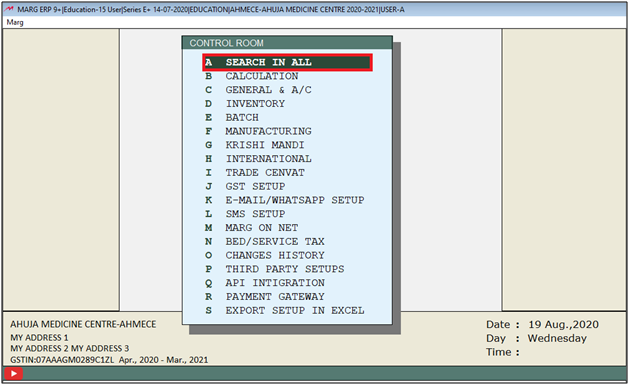
- A 'Controls' window will appear in which the user will Search 'Audit Trial'.
- Now click on ‘Accept’.

- An 'Audit Trial' window will appear.
- In 'Activate Audit Trial from Today' option, the user will select 'Y'.
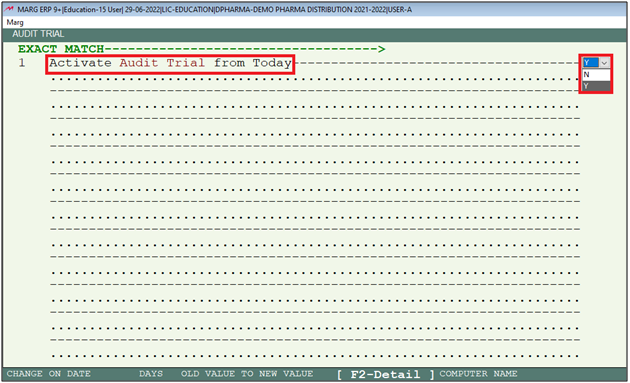
- The user will now press 'ESC' key twice.
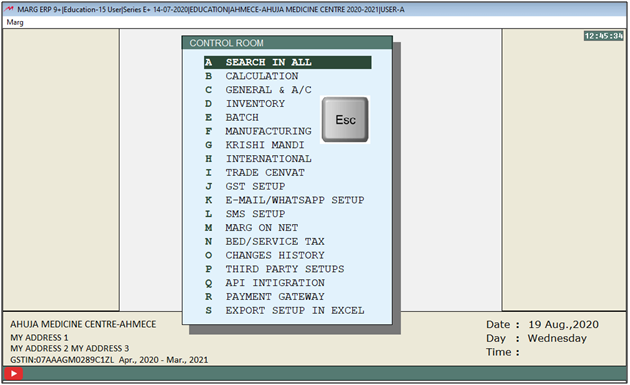
- Now click on ‘Yes’ to save the changes.
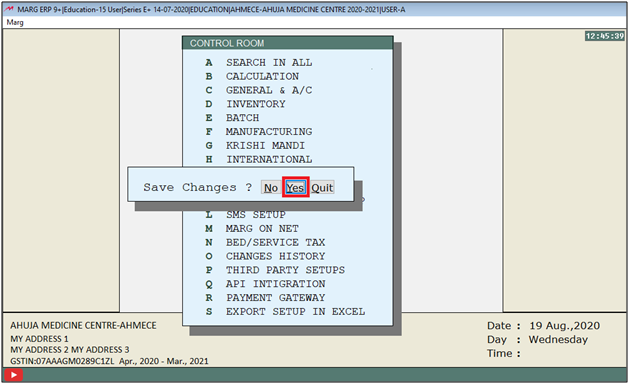
- Now an 'Audit From Date' window will appear where the user will mention the date from which the Audit Trail option needs to be enabled.
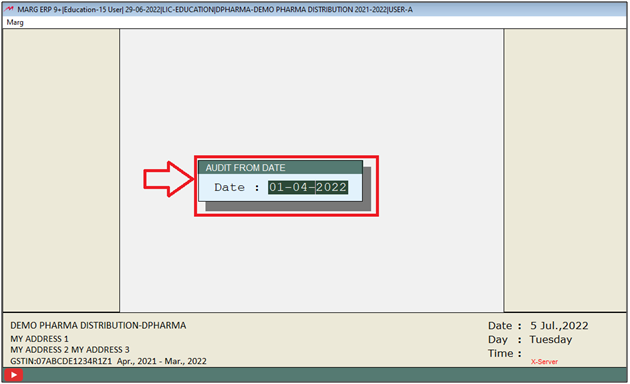
PROCESS OF AUDIT TRAIL IN MARG ERP SOFTWARE
a. Bill Value Changes: In this tab, the user can view the detail of the bills in which the changes has been made i.e. changes in the bill value, changes in the quantity of the item, deleted bills, cancelled bills.
- Go to Daily Reports >> Audit Trail >> Bill Value Changes.
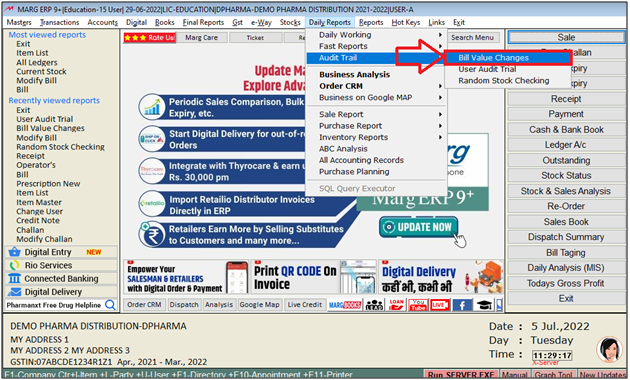
a. Period: The user will mention that period of which Audit Trail needs to be viewed.
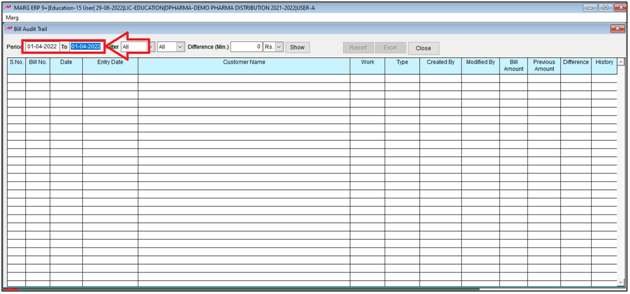
b. Filter: The user will select the transactions (Sale, Purchase etc.) which needs to be viewed in this report.
Suppose the user needs to view all transactions so selecting 'All' from the dropdown.
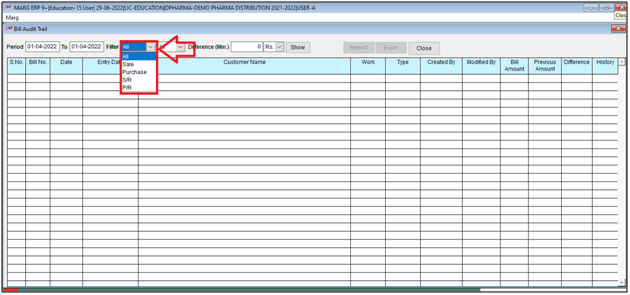
- Now the user will select that which type of changes the software will display in this report i.e. Value, Delete, Cancel etc.
- Suppose select 'All'.
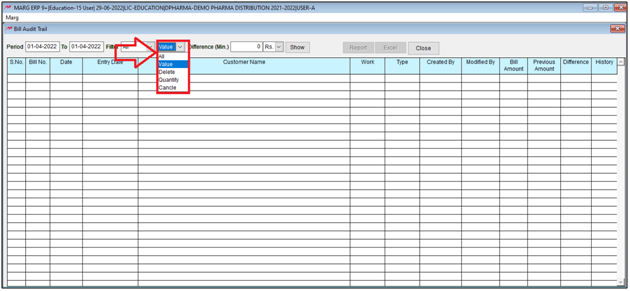
c. Difference Amount: The user will mention the minimum amount which would be consider in the report and if the user needs to view the report of all amount then keep the amount field as blank.
Then click on 'Show'.

- Now the user can view all the bills of selected date range in which the changes have been made.
- In order to view the detailed information of user of particular bill, the user needs to click on 'View'.
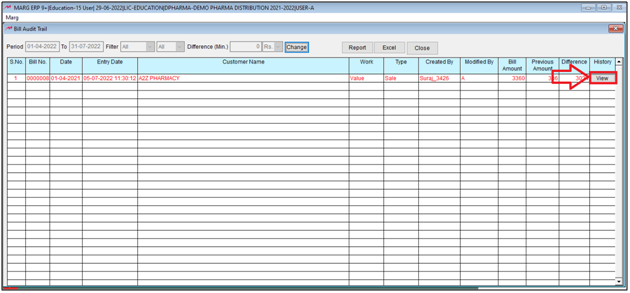
- In this way the user can view all the details of selected sale bill.

b. User Audit Trail: With the help of this option the user can view all the workings done by their operator.
- For this Go to Audit Trail > User Audit Trail.
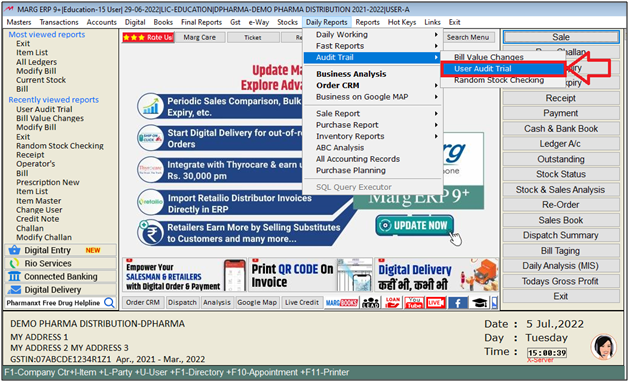
- A ‘User Workbook’ window will appear with different fields:
a. Period: In ‘Period’ field, the user will mention that period of which Audit Trail needs to be viewed.
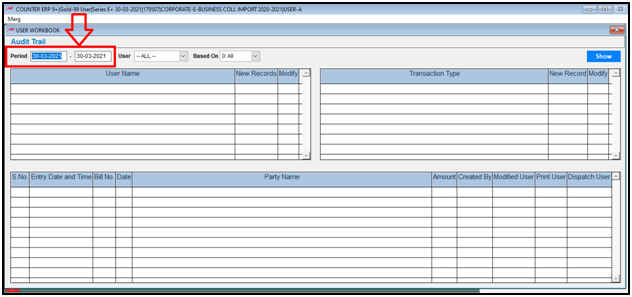
b. User: In ‘User’ field, if the user needs to view the record of all users then select ‘All’ else select a particular user whose Audit Trail needs to be viewed.
Suppose select ‘All’.

c. Based on: Select the basis on which the Audit Trail of the user needs to be viewed i.e. All, Bill, Challan and Accounts.
Suppose select ‘All’.
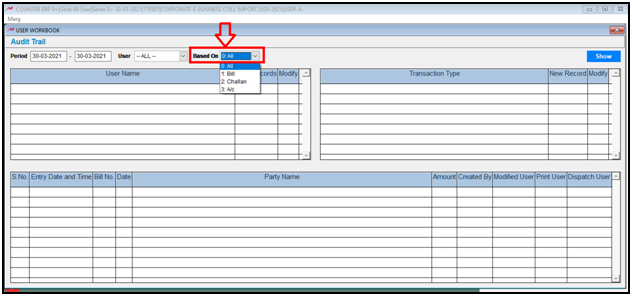
- Then click on ‘Show’.
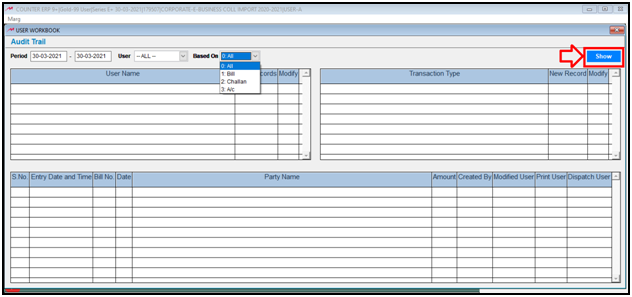
- Now the username will be displayed along with the number of bills created by which user and number of bills modified by which user.
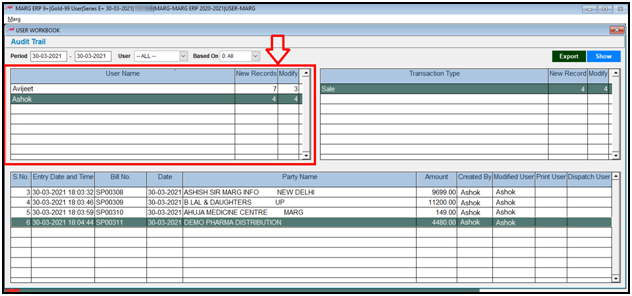
- Also, user wise transactions will get displayed on the right side.

- Suppose select ‘Ashok’. It shows that this particular user has done the transaction of sales and has modified it for 4 times.

- Then whatever transaction type will be selected, the entries related to that will be displayed below.

- Now select the entry of whose Audit Trail needs to be viewed and then press ‘Enter’ key.
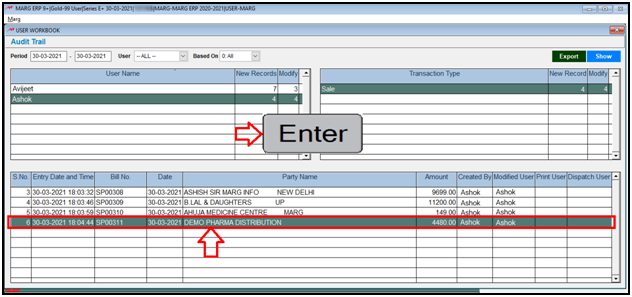
- Then a pop up of ‘Enter Your Choice’ will appear with 2 options i.e. View Bill and Audit Trail.
- If the user needs to view the bill then click on ‘View Bill’ and view the bill.
- And if the user needs to view the Audit Trail then click on ‘Audit Trail’.
- Suppose select ‘Audit Trail’.

- A window of ‘Audit Trail’ will get displayed that this particular user has modified the bill along with the details like on which date it has been modified and through which machine it has been modified.

c. Random Stock Checking: With the help of this option, the owner/supervisor of the company can Randomly cross check the physical & software stock.
Because sometimes it is not being easy for the supervisor to cross check the stock of each & every item available in the shop/store. So this option facilitates the user to verify the stock of some items randomly.
- For this Go to Audit Trail > Random Stock Checking.
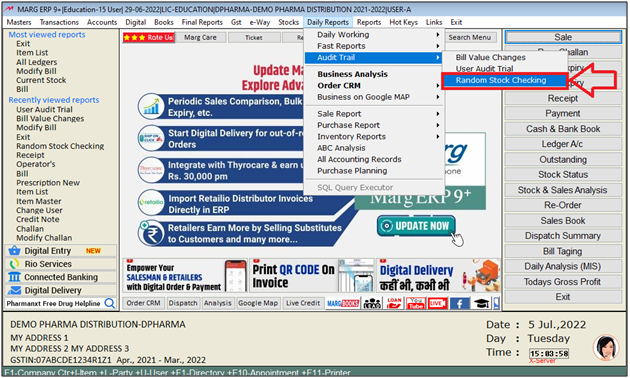
- A 'Select Company' window will appear.
- The user will select the company as per the requirement.
Note: A single company can be selected by space bar or plus (+) key and all can be selected by Asterisk (*) key.
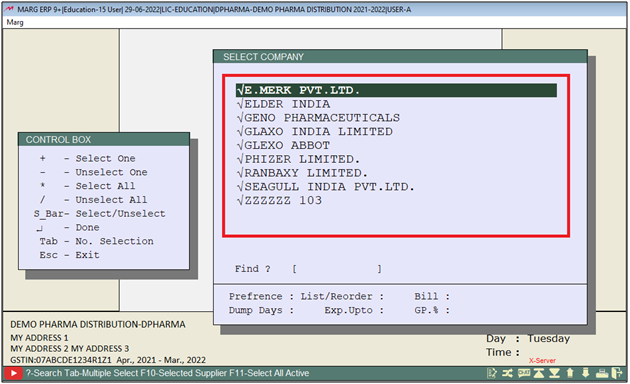
- Now the user will mention the number of items which needs to be used while cross checking the physical & software stock.
- Suppose mention '20' items.

After following the above steps, the user can view closing stock of defined items.
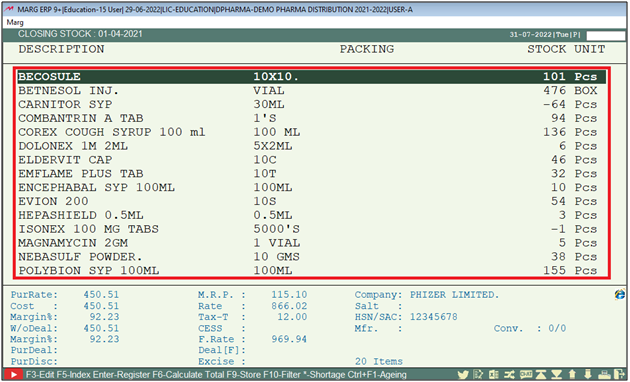


 -
Marg ERP 9+
-
Marg ERP 9+











